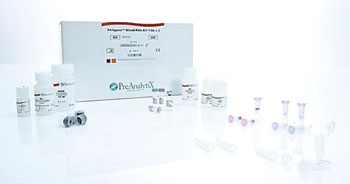MicroRNA Could Help Diagnose Mental Disorders
By LabMedica International staff writers
Posted on 02 Jul 2014
The link between dysregulated serotonergic activity and depression and anxiety disorders is well established, yet the molecular mechanisms underlying these psychopathologies are not fully understood.Posted on 02 Jul 2014
The etiology of depression and/or anxiety disorders is a complex interaction between environmental factors and genetic predisposition, possibly suggesting a mechanistic role for epigenetic processes, and such mood disorders as depression affect some 10% of the world's population and are associated with a heavy burden of disease.

Image: The PAXgene Blood RNA Kit for the extraction of intracellular ribonucleic acid (Photo courtesy of Qiagen).
Scientists at the Weizmann Institute of Science (Rehovot, Israel) investigated the molecular mechanisms of the brain's serotonin system, which, when misregulated, is involved in depression and anxiety disorders. They explored the role of micro ribonucleic acid (miRNA) molecules in the nerve cells that produce serotonin.
Total RNA was isolated using the PAXgene Blood RNA Kit (QIAGEN; Valencia, CA, USA) from both mice and human subjects. The team identified for the first time, the unique "fingerprints" of a microRNA molecule that acts on the serotonin-producing nerve cells. Combining bioinformatics methods with experiments, they found a connection between a particular microRNA, miR135, and two proteins that play a key role in serotonin production and the regulation of its activities. The scientists noted that in the area of the brain containing the serotonin-producing nerve cells, miR135 levels increased when antidepressant compounds were introduced.
The investigators found that subjects who suffered from depression had unusually low miR135 levels in their blood. On closer inspection, the scientists discovered that the three genes involved in producing miR135 are located in areas of the genome that are known to be associated with risk factors for bipolar mood disorders. The authors concluded that their findings suggest that miR135 could be a useful therapeutic molecule, both as a blood test for depression and related disorders, and as a target whose levels might be raised in patients. The study was published on June 19, 2014, in the journal Neuron.
Related Links:
Weizmann Institute of Science
QIAGEN














